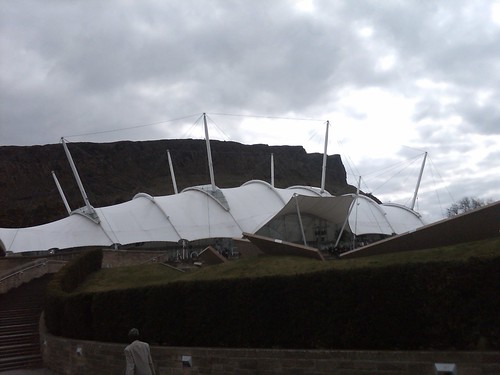Swine Flu in the classroom (no, not in that way...)
Categories: s1 and s2, Geography General
With s1 today, I decided to take a break between topics and try to do something about the swine flu epidemic which has been in the news. I started the period with a photo from flickr blown up on the board:-
 Many thanks to hmerinomx flickr user. Most of the kids knew straight away that the location was Mexico and that we would be talking about swine flu, so I decided to try a starter which would help us understand how flu spreads. I asked students first of all to turn to the person next to them and share what they knew, thought or had heard about swine flu. This took no time at all. They then had to pass this down their row to the front, and a person in the front desk had to report back to the rest of the class on the accumulated knowledge. This illustrated two things- that person to person was a very quick way to pass things on, without any contact needed, and that sometimes some things did not pass on well. There were inevitably some things which had been mentioned somewhere in the row which the spokesperson had forgotten or had not been told. This was quite good as one of the rows had already fed back that an estimated 40% of people could potentially contract the disease, so I wanted to illustrate that the probability of everyone catching swine flu was very remote. I further emphasised the point about the ease of which a flu virus could be passed by asking Miss MacKay to record incidences of people touching their mouths, nose or coughing/ sneezing during the activity. This led on to another discussion about how contagious this was. From this, we defined what was meant by a pandemic.
Many thanks to hmerinomx flickr user. Most of the kids knew straight away that the location was Mexico and that we would be talking about swine flu, so I decided to try a starter which would help us understand how flu spreads. I asked students first of all to turn to the person next to them and share what they knew, thought or had heard about swine flu. This took no time at all. They then had to pass this down their row to the front, and a person in the front desk had to report back to the rest of the class on the accumulated knowledge. This illustrated two things- that person to person was a very quick way to pass things on, without any contact needed, and that sometimes some things did not pass on well. There were inevitably some things which had been mentioned somewhere in the row which the spokesperson had forgotten or had not been told. This was quite good as one of the rows had already fed back that an estimated 40% of people could potentially contract the disease, so I wanted to illustrate that the probability of everyone catching swine flu was very remote. I further emphasised the point about the ease of which a flu virus could be passed by asking Miss MacKay to record incidences of people touching their mouths, nose or coughing/ sneezing during the activity. This led on to another discussion about how contagious this was. From this, we defined what was meant by a pandemic.
The next thing I wanted to ask students was 'Should we be afraid?'. I wanted to separate out media hype from reality. We used a great google map and mapped the countries which were showing cases or suspected cases of swine flu:-
View H1N1 Swine Flu in a larger map
We used this to also read a bit more about the extent to which the outbreaks had affected countries. In most cases the incidences had been caught quickly and were now being treated. I also wanted students to see how people perceived swine flu, so we used a live tweet map. I was a bit worried about using this, but I thought it was worth the risk and seemed to go down really well with the students. There was a mixture of jokes about swine flu and others who obviously had colds or flu symptoms fearing armageddon! Only a few of the tweets had any serious information about the virus. From this, we concluded that people had been panicked and others did not take the risk seriously enough. I spoke about the WHO and their alert levels round about this point.
I would have liked to have used this BBC map with multimedia resources to help us understand if this virus could be treated/ contained, but I wanted to make sure that we had time at the end for students to try to stem an imaginary flu outbreak through this game. This was very good for looking at the spatial spread of disease in a short time span. After going to bed last night thinking that the lesson was abit sketchy, I was very pleased with both the way the students engaged with the lesson and the way that the resources worked. I am sure some of these resources must have been bookmarked from sln and the google map is something I originally saw on Keir Clarke's blog, so many thanks to those who provided both information and inspiration for this.












